World War II
Kristallnacht
09/11/23 08:40 Filed in: History
Today this the 85th Anniversary of Kristallnacht in Germany. It was felt to be the visible beginning of the Holocaust for the Jews.
Information from The Lid Blog about that day and the Anniversary follows —
Kristallnacht, the Night of Broken Glass, was a nationwide anti-Jewish pogrom in Nazi Germany. It began on the evening of November 9, 1938, and continued through the next day…
Kristallnacht was a coordinated attack on the Jewish people and their property, 99 Jews were murdered, 25,000 to 30,000 were arrested and placed in concentration camps. Two hundred and sixty-seven synagogues were destroyed, and thousands of homes and businesses were ransacked. Just Like Hamas did to Kibbutzim on Oct. 7th.
The attacks were carried out by the Hitler Youth, the Gestapo, and the SS. Kristallnacht also served as a pretext and a means for the wholesale confiscation of firearms from German Jews and was part of the broader Nazi policy of Antisemitism. Kristallnacht was followed by more horrific anti-Semitic economic and political abuses and horrible genocide.
Information from The Lid Blog about that day and the Anniversary follows —
Kristallnacht, the Night of Broken Glass, was a nationwide anti-Jewish pogrom in Nazi Germany. It began on the evening of November 9, 1938, and continued through the next day…
Kristallnacht was a coordinated attack on the Jewish people and their property, 99 Jews were murdered, 25,000 to 30,000 were arrested and placed in concentration camps. Two hundred and sixty-seven synagogues were destroyed, and thousands of homes and businesses were ransacked. Just Like Hamas did to Kibbutzim on Oct. 7th.
The attacks were carried out by the Hitler Youth, the Gestapo, and the SS. Kristallnacht also served as a pretext and a means for the wholesale confiscation of firearms from German Jews and was part of the broader Nazi policy of Antisemitism. Kristallnacht was followed by more horrific anti-Semitic economic and political abuses and horrible genocide.
Comments
Jewish Trove Found in Lodz Poland
10/01/23 08:57 Filed in: History
One of the most heartbreaking and evil acts was the removal and extermination of Jews by the Nazis during World War ll from long established Jewish population centers. Man's inhumanity to other men or what they believe is an inferior culture. Have we move past this sort of behavior? I doubt it. What is called othering is still occurring today and will in the future.
Construction workers renovating an old tenement house in Lodz, Poland, unearthed a surprising find: an untouched cache of hundreds of Jewish artifacts believed to have been hidden in advance of the Nazi occupation of the city.
The trove — which included menorahs, kiddush and ritual washing cups and items from everyday life, all wrapped carefully in newspaper — was buried next to a building just beyond the ghetto in which Lodz’s Jews were imprisoned during the Holocaust. Only about 10,000 Lodz Jews survived until the end of the war, out of a prewar population of about 230,000.
https://www.jpost.com/diaspora/article-728088
Construction workers renovating an old tenement house in Lodz, Poland, unearthed a surprising find: an untouched cache of hundreds of Jewish artifacts believed to have been hidden in advance of the Nazi occupation of the city.
The trove — which included menorahs, kiddush and ritual washing cups and items from everyday life, all wrapped carefully in newspaper — was buried next to a building just beyond the ghetto in which Lodz’s Jews were imprisoned during the Holocaust. Only about 10,000 Lodz Jews survived until the end of the war, out of a prewar population of about 230,000.
https://www.jpost.com/diaspora/article-728088
More Battle of the Bulge
03/02/17 13:44 Filed in: History
The internet seems to be putting out more photos and information around the Battle of the Bulge from World War II. This article explains why it was Hitler's last hoorah and the stake through his heart.
The Soviet LifeStyle
03/09/16 08:51 Filed in: History
Bob and I have a number of history books about Russia and the period of communism as the Soviet Union. One knows of the horror of communism as it was put upon the Russian people if you delve into it. Sadly the horrors of Nazi Germany and Hitler are taught more with the horrors of Stalin is glossed over. The books of Robert Conquest of "The Great Terror" and "Harvest of Sorrow" will set you correct. The detail is horrifying to say the least. This article goes on to summarize the worst of totalitarianism.
"Ninety-nine years ago, Tsar Nicholas II abdicated, and, after a few months of weak parliamentary rule, the Bolsheviks seized power. We call that seizure the Russian (or October) Revolution, but it might better be designated the Bolshevik coup d’état. A party of 10,000 people gained control of an empire occupying one-sixth of the earth’s land area.
From the start, they made up for their small numbers with outsized violence. If at first their executions of liberals, socialists, workers who showed independence, and peasants from whom grain was seized at gunpoint seemed like a short-term necessity, it soon became evident that the violence would never stop. In fact, it was to grow, with Stalin proclaiming “the intensification of the class struggle” when Bolshevik control had long been total."
"Ninety-nine years ago, Tsar Nicholas II abdicated, and, after a few months of weak parliamentary rule, the Bolsheviks seized power. We call that seizure the Russian (or October) Revolution, but it might better be designated the Bolshevik coup d’état. A party of 10,000 people gained control of an empire occupying one-sixth of the earth’s land area.
From the start, they made up for their small numbers with outsized violence. If at first their executions of liberals, socialists, workers who showed independence, and peasants from whom grain was seized at gunpoint seemed like a short-term necessity, it soon became evident that the violence would never stop. In fact, it was to grow, with Stalin proclaiming “the intensification of the class struggle” when Bolshevik control had long been total."
Radiation Effects
19/08/16 11:41 Filed in: History
Sunken Aircraft Carrier
23/08/16 08:15 Filed in: History
What does a sunken aircraft carrier look like in the depths of the ocean? Mighty or not mighty in appearance? The carrier, the USS Independence, of Jaws movie fame came into being in World War II. It was sunk purposefully in the 1950s. Now they are exploring the vessel deep in the ocean to gather its secrets. More here.
"The USS Independence joined the Pacific Fleet in 1943, participating in several raids on Japanese installations before encountering the business end of a torpedo. After a patch-up, it returned to fighting for the remainder of WWII, before encountering the business end of two nuclear bombs".
"The USS Independence joined the Pacific Fleet in 1943, participating in several raids on Japanese installations before encountering the business end of a torpedo. After a patch-up, it returned to fighting for the remainder of WWII, before encountering the business end of two nuclear bombs".
The Greatest Documentary
17/05/16 15:43 Filed in: History
Holocaust Liberation
02/05/16 12:17 Filed in: History
A beautiful photo and story about the liberation of some Holocaust survivors. I imagine it was an incredibly liberating experience to see someone coming to their rescue after being on the edge of death for so long.
The French Resistance
11/02/16 14:38 Filed in: History
There has always been a mix of romance and controversy surrounding the French Resistance movement from World War II. Now there are two books out about this part of our more recent history. Read about it in the NYRB.
Stalin's Size
14/01/16 15:25 Filed in: History
I've posted several blogs about Stalin, a thoroughly evil man. He was short though still taller than me. Maybe he had small man's syndrome. Nope, he was a megalomaniac without that I believe. He did try to hide his small stature and look larger in photos than he was in real life. Check it out.
The Ardennes in 1944
13/12/15 06:34 Filed in: History
I have a fair size collection of history books about World War II. One author I also have read and have at least one of his books is Antony Beevor. He has a new book out about the Battle of the Bulge, a significant battle in the month of December in 1944. Watch Band of Brothers as a TV show and one will see. A bit more about the book can be found here.
"Antony Beevor, one of the finest narrative military historians now writing, is a master of revealing vignettes like this one. The Battle of the Bulge, from mid-December 1944 through January 1945, the subject of “Ardennes 1944,” is a known story — Hitler’s last roll of the dice in the West, stripping other fronts (including the East) of prime armored and infantry units to hurl some 30 divisions at the weakly defended American line in the Ardennes forest. It was here that the Germans had dazzlingly shattered French resistance in May 1940, driving tank armies through the forests, defiles and villages of this compact hill country. The hope now was to split the Allied armies, shattering the Americans and driving the British into an evacuation. It was a fantasy: The German military — sorely lacking in fuel; its cadres of experienced sergeants and officers depleted by years of high casualties; short of food and ammunition, let alone the transport to move them; and inferior in the air — could probably not have succeeded. But at the price of around 80,000 casualties on each side, it gave the Americans and British a real scare."
"Antony Beevor, one of the finest narrative military historians now writing, is a master of revealing vignettes like this one. The Battle of the Bulge, from mid-December 1944 through January 1945, the subject of “Ardennes 1944,” is a known story — Hitler’s last roll of the dice in the West, stripping other fronts (including the East) of prime armored and infantry units to hurl some 30 divisions at the weakly defended American line in the Ardennes forest. It was here that the Germans had dazzlingly shattered French resistance in May 1940, driving tank armies through the forests, defiles and villages of this compact hill country. The hope now was to split the Allied armies, shattering the Americans and driving the British into an evacuation. It was a fantasy: The German military — sorely lacking in fuel; its cadres of experienced sergeants and officers depleted by years of high casualties; short of food and ammunition, let alone the transport to move them; and inferior in the air — could probably not have succeeded. But at the price of around 80,000 casualties on each side, it gave the Americans and British a real scare."
Nuremberg Anniversary
20/11/15 05:49 Filed in: History
Seventy years ago today was the start of the Nuremberg Trial of German leaders for war crimes. Here is an interesting article about three men who advocated for the trials and three roads to achieve the end results.
"Much of what we now understand as the Holocaust—the persecution of the German Jews in the 1930s, the evolution of systematic, European-wide mass murder during the Second World War, the number 6 million, ghettoization, the rampages of the Einsatzgruppen, the death camps in Eastern Europe, the uprising of the Warsaw Ghetto—became part of the proceedings of the Nuremberg Trial of 1945-46 thanks in good measure to three Jewish advocates, none of whom was formally part of the prosecution. Each of them was a lawyer; each was an émigré from an Eastern Europe ravaged by the slaughter of Jewish people during the war, and each, in his own way, drew an important conclusion drawn from the catastrophe that his community of origin had undergone."
"Much of what we now understand as the Holocaust—the persecution of the German Jews in the 1930s, the evolution of systematic, European-wide mass murder during the Second World War, the number 6 million, ghettoization, the rampages of the Einsatzgruppen, the death camps in Eastern Europe, the uprising of the Warsaw Ghetto—became part of the proceedings of the Nuremberg Trial of 1945-46 thanks in good measure to three Jewish advocates, none of whom was formally part of the prosecution. Each of them was a lawyer; each was an émigré from an Eastern Europe ravaged by the slaughter of Jewish people during the war, and each, in his own way, drew an important conclusion drawn from the catastrophe that his community of origin had undergone."
Battle of Leyte Gulf
23/10/15 16:46 Filed in: History
VJ Day 70 Years Later
16/08/15 19:59 Filed in: History
When Hirohito surrendered on August 15, 1945, everyone thought the war was over with Japan. Some kamikazes still believed they could defend the homeland and tried. They attacked American planes as they approached Japan. At least one young soldier died as the result of the attack. Americans were preparing for the resumption of hostilities and maybe another nuclear bomb, possibly on Tokyo itself. Because the surrender delegation continued their journey to meet MacArthur, no further hostilities were started. More can be read here about this episode of history.
The Atom Bombs
06/08/15 20:53 Filed in: History
Battle of Britain 75 Years Later
10/07/15 11:45 Filed in: History
How was the Battle of Britain won? They were under the gun of a determined Nazi Germany to defeat them. Britain is what stood between us and the further collapse of world order. This article is a remembrance from some of the aces (flying a Hurricane) from that time. Brave men who helped save us all.
Hitler's Bed
24/06/15 09:59 Filed in: History
There is a lot of controversy going on currently that centers around removing the Confederate battle flag. I have not ever been a fan of the flag and my ancestors fought for the North. I do find it troubling how off the wall crazy this is getting. I am still a fan of history and one cannot change it or hide it. Also, it is going to drive supporters under ground or harden their "defenses". Better to have open dialogue and handle it.
On another note, with all of that hysteria, I read about an Englishman who is a Nazi memorabilia collector. He is not a supporter of Nazism it sounds but he is wrapped up in saving Third Reich artifacts for posterity. The story is here.
On another note, with all of that hysteria, I read about an Englishman who is a Nazi memorabilia collector. He is not a supporter of Nazism it sounds but he is wrapped up in saving Third Reich artifacts for posterity. The story is here.
Goebbels
27/05/15 14:26 Filed in: History
A person most associated with the power and persuasion of propaganda is Goebbels, one of Adolph Hitler's henchmen. We don't know much about the man since little is often written about him compared to some of the others surrounding Hitler. Someone has now come out with a biography of his life (and death with his wife and children). More can be read here.
Men Who Pulled The Triggers
17/05/15 16:42 Filed in: History
What makes some people follow orders and do horrific crimes in the "normal" course of their lives or duties? What made Germans and others turn on Jews, Gypsies, and others to lead them to their deaths or commit the act of murder. A new book might have some insight. The review is here.
"We know a lot about how the Germans carried out the Holocaust. We know much less about how they felt and what they thought as they did it, how they were affected by what they did, and what made it possible for them to do it. In fact, we know remarkably little about the ordinary Germans who made the Holocaust happen -- not the desk murderers in Berlin, not the Eichmanns and Heydrichs, and not Hitler and Himmler, but the tens of thousands of conscripted soldiers and policemen from all walks of life, many of them middle-aged, who rounded up millions of Jews and methodically shot them, one by one, in forests, ravines and ditches, or stuffed them, one by one, into cattle cars and guarded those cars on their way to the gas chambers.
In his finely focused and stunningly powerful book, "Ordinary Men: Reserve Police Battalion 101 and the Final Solution in Poland," Christopher R. Browning tells us about such Germans and helps us understand, better than we did before, not only what they did to make the Holocaust happen but also how they were transformed psychologically from the ordinary men of his title into active participants in the most monstrous crime in human history. In doing so he aims a penetrating searchlight on the human capacity for utmost evil and leaves us staring at his subject matter with the shock of knowledge and the lurking fear of self-recognition."
"We know a lot about how the Germans carried out the Holocaust. We know much less about how they felt and what they thought as they did it, how they were affected by what they did, and what made it possible for them to do it. In fact, we know remarkably little about the ordinary Germans who made the Holocaust happen -- not the desk murderers in Berlin, not the Eichmanns and Heydrichs, and not Hitler and Himmler, but the tens of thousands of conscripted soldiers and policemen from all walks of life, many of them middle-aged, who rounded up millions of Jews and methodically shot them, one by one, in forests, ravines and ditches, or stuffed them, one by one, into cattle cars and guarded those cars on their way to the gas chambers.
In his finely focused and stunningly powerful book, "Ordinary Men: Reserve Police Battalion 101 and the Final Solution in Poland," Christopher R. Browning tells us about such Germans and helps us understand, better than we did before, not only what they did to make the Holocaust happen but also how they were transformed psychologically from the ordinary men of his title into active participants in the most monstrous crime in human history. In doing so he aims a penetrating searchlight on the human capacity for utmost evil and leaves us staring at his subject matter with the shock of knowledge and the lurking fear of self-recognition."
Russia's Take on Current Times
16/05/15 16:32 Filed in: History
Timothy Snyder is an author I have mentioned in this blog a number of times. He has written a number of books and articles about the area and political times between Germany and the Soviet Union before and during World War II. His description of the turmoil, war and totalitarian methods during the 1930s and 40s is startling and gruesome. Here is an interesting article of his evaluating how Vladimir Putin is using the Hitler/Stalin pact of 1939 as a basis for his actions toward the Ukraine and other countries now. This Pact was taboo in Russia for many years since Hitler turned on Stalin to attach the Soviet Union. Interesting and concerning where this goes now.
VE Day
08/05/15 07:08 Filed in: History
Another anniversary today though not a Centennial, a 70th Anniversary of VE Day, Victory in Europe. The United States was celebrating the surrender of Nazi Germany this day in history. It was neat to see the news casts show a World War II fly over of the Washington DC monuments and the Capitol Mall that was held for the remaining World War II veterans who could attend. These men saved us and the world. At least at that time. I hope they did not save us so our current President and his groupees can turn around now and give the world back to other bad guys.
Before Auschwitz
22/04/15 20:39 Filed in: History
In the early days of Hitler's term as German Chancellor, many Jews and undesirables went to work camps or early concentration camps. James Rosen writes a very interesting book review of a book on Jewish Prisoners in prewar camps. Surprisingly a fair number of these individuals escaped and survived compare to prisoners at later camps. To learn more about this disturbing time in history, please go here.
Old Nazi Hideouts in Argentina
24/03/15 16:22 Filed in: History
They captured Adolph Eichmann in Argentina. We know conventional wisdom says many German Nazis escaped at the end of the war to countries on the eastern side of South American. Mengele lived in Brazil plus Paraguay, I believe, until he died. They found some old buildings, hideouts, in the jungle in Argentina near the border with Paraguay. Just more evidence of the stories that would make up "The Odessa File". Here is a fascinating story found in the Washington Post.
Faces of Auschwitz
27/01/15 08:45 Filed in: History
It is the 70th anniversary of the liberation of the Auschwitz concentration camp in Poland. There have been a number of ceremonies featuring the survivors, especially that the numbers are dwindling due to time and age.
I came across this Flashback of photos from that time period and on. Many of these have been seen elsewhere though not all through this blog. Please see the faces of those who survived and others.
I came across this Flashback of photos from that time period and on. Many of these have been seen elsewhere though not all through this blog. Please see the faces of those who survived and others.
The Klaus Barbie Trial
20/01/15 10:36 Filed in: History
There is so much of what is happening in France lately to the Jews that relates back to the history of how the holocaust affected them in that country. For a bit of a history lesson on one of the worst Gestapo offenders put on trial after the war, one should read about Klaus Barbie.
Bastogne, 70 years ago
26/12/14 15:12 Filed in: History
There have been a number of articles reminding us of the Battle of the Bulge and the relief of Bastogne during the Christmas holidays of 1944. American soldiers were surrounded by German troops. Their indomitable spirit and the arrival of Patton's troops helped save the dire situation. An article about what happened 70 years ago is found here.
Poland
12/12/14 08:35 Filed in: History
I love to be able to travel and there are a number of places I would like to visit in this world. Traveling to Poland is one. Visiting Warsaw and Cracow would be top of the list. Due to their rich history and culture. Culture that that was deeply damaged and changed within the last 75 years. The first Jews arrived in the 10th century to the area that is Poland. They made up a large percentage of the population until nearly exterminated during World War II. Their story is the story of Poland too even though there are not large numbers there now. Poland has recently opened a new museum that looks at the History of Polish Jews over time since their arrival there. From reading this article and others, there is now additional reasons to visit the area. The museum is built in the heart of the Warsaw ghetto where so much loss of life and significance from World War II.
Kamikaze Pilots
26/11/14 06:46 Filed in: History
During World War ll, one of the most alarming aspects of the Asian/Pacific theatre was the development of the Japanese Kamikaze pilot. One bit of trivia is information about how the pilots were chosen. Ultimately, it came down to pressure and peer-pressure. A more extreme version of this scenario is the suicide bomber found World-wide though primarily in the Middle-East.
Paperback Books and World War ll
Did paperback books help win World War ll for the Citizen Soldier? Did it help with their war experience and to pass the time? Maybe this was their type of dime store novel. Find out the background here.
“A decade after the Nazis’ 1933 book burnings, the U.S. War Department and the publishing industry did the opposite, printing 120 million miniature, lightweight paperbacks for U.S. troops to carry in their pockets across Europe, North Africa and the Pacific.
The books were Armed Services Editions, printed by a coalition of publishers with funding from the government and shipped by the Army and Navy. The largest of them were only three-quarters of an inch thick—thin enough to fit in the pocket of a soldier’s pants. Soldiers read them on transport ships, in camps and in foxholes. Wounded and waiting for medics, men turned to them on Omaha Beach, propped against the base of the cliffs. Others were buried with a book tucked in a pocket.”
“A decade after the Nazis’ 1933 book burnings, the U.S. War Department and the publishing industry did the opposite, printing 120 million miniature, lightweight paperbacks for U.S. troops to carry in their pockets across Europe, North Africa and the Pacific.
The books were Armed Services Editions, printed by a coalition of publishers with funding from the government and shipped by the Army and Navy. The largest of them were only three-quarters of an inch thick—thin enough to fit in the pocket of a soldier’s pants. Soldiers read them on transport ships, in camps and in foxholes. Wounded and waiting for medics, men turned to them on Omaha Beach, propped against the base of the cliffs. Others were buried with a book tucked in a pocket.”
From Funny to Serious
28/10/14 19:15 Filed in: History
Anne Applebaum who is a compelling writer reviews the first volume of three planned books of an extensive biography of Stalin. The premise here is not that he was crazy or devious but rose to the top of this group because he was smart and ambitious. It pays to understand Stalin because many still wish he was in charge of Russia and admire what he achieved. There also could be more like him out there in the future. Know thy enemy. Read about it here.
Warsaw Uprising Anniversary
02/08/14 09:26 Filed in: History
August 1, 1944 was the start of the Warsaw uprising in the ghetto by the Jews against the Germans. This is the 70th anniversary of the start of the Uprising. By the end, most of the Jews were dead, wiped out by the Germans while the Soviets stood by and let it happen. A haunting story of one survivor’s memory of the time can be found in this article.
“On Friday, Mikos will be among a shrinking group of insurgents to be honored in state ceremonies marking the 70th anniversary of the start of the 1944 Warsaw Uprising. In this uneven struggle, poorly armed young city residents rose up against the German forces that had brutally occupied Poland for five years, battling them in the streets of the capital for over two months.”
“On Friday, Mikos will be among a shrinking group of insurgents to be honored in state ceremonies marking the 70th anniversary of the start of the 1944 Warsaw Uprising. In this uneven struggle, poorly armed young city residents rose up against the German forces that had brutally occupied Poland for five years, battling them in the streets of the capital for over two months.”
A Letter From D-Day
15/07/14 06:56 Filed in: History
This summer is the 70th anniversary of the D-Day invasion during World War II. A recent article in Commentary published the letter home to his parents from a soldier who was preparing to attach the beaches. The amazing courage of our citizen soldiers is beyond understanding yet so appreciated. The soldier survived the war. It is a tribute when one of his extended family finds this letter and shares it with all of us here. The original link was broken so a related link was substituted.
An Unbroken Hero
Recently, an amazing man and a hero out of World War II passed away. The man is Louis Zamparini and he died at the age of 97. He was a pilot in World War II who survived his planed crashing in the Pacific war theatre followed by many days afloat in the ocean trying to make land. He was then captured by the Japanese and with that, survived a brutal incarceration by the Japanese through to the end of the war. Mr. Zamparini was the central focus of the best selling book, Unbroken. For a moving summary of his exploits and character, it can be found here from the Weekly Standard.
D-Day, 70 Years Ago
06/06/14 20:14 Filed in: History
Today is the 70th anniversary of D-Day, the landings in Normandy. How amazing and brave those men were. Our Citizen Soldiers as Stephen Ambrose called them. Ceremonies were conducted today at the Normandy memorials and at the cemeteries. Much has been written about that day, here is a collection of photos from the Capa gallery. At the same time, here is the speech Gen. Eisenhower gave to the men of the Allied Expedition.
Anzio
05/06/14 20:05 Filed in: History
We are dealing with 70 year old anniversaries this year of episodes during World War ll. On May 25, it was the 70th anniversary of the breakthrough at Anzio in Italy. The Anzio beachhead was considered a way to bypass German lines and flank their armies in Italy. Unfortunately, it did not work out as planned or hoped. Here is an article of the breakthrough to where the Allied Armies could control Italy.
Jews in Denmark in World War II
03/04/14 10:29 Filed in: History
Why did Denmark’s Jews escape the round up and capture to be sent to concentration camps that happened in other European countries? Why did the citizens of Denmark protect their Jewish population more and help many of them to escape from the Nazi overrule. A discussion of this can be found in an article here.
“And yet the question that has been nagging many people since the second world war is why the record of some nations appears to have been so much better than others. Why, for example, did more than 70% of Dutch Jews disappear into the death camps, while almost all the Jews in Denmark managed to get away safely?”
“And yet the question that has been nagging many people since the second world war is why the record of some nations appears to have been so much better than others. Why, for example, did more than 70% of Dutch Jews disappear into the death camps, while almost all the Jews in Denmark managed to get away safely?”
Battle of the Bulge
10/02/14 13:59 Filed in: History
Reading World War II history is fascinating. Certainly the particulars of the final push of Nazi German to regain ground and the momentum against the western Allies in the Battle of the Bulge is one such description. A very nicely put together and concise history of this part of the war can be found here at the historyplace.com.
Hitler versus Stalin
05/03/14 20:28 Filed in: History
I have written previously about a very good history professor and author, Timothy Snyder. He is a professor at Yale University and has considerable expertise on the Eastern European sphere of World War II. He currently has an article about how we should view the acts of Hitler versus Stalin. Who might be worse? Are the shear numbers of people killed more horrendous than the way they were killed? Did the killings overlap in some countries and could be attributed in some manner to both men? Even out of these numbers, even the difference of one is a human soul that should be mourned. It takes a lot of “ones” to add up to the millions lost. Snyder claims that the numbers attributed to Stalin may be less than surmised since more came back from the Gulag alive than previously reported. Yet, the numbers lost before the war were great and often not considered to the level of casualties during the war. Please read his work here.
Hitchcock and the Holocaust
13/01/14 08:41 Filed in: Interests
It was not a well known fact that Alfred Hitchcock, a master film maker, produced a documentary in 1945 of the liberation of the Bergen Belsen concentration camp. Hitchcock was so disturbed by the images he saw on the film and also due to other factors that the film has not been shown. It was archived away for many years. It is now to be released. Five of six reels of film were stored at the Imperial War Museum, a museum Bob and I visited while on a London visit. It is an excellent spot to spend time in and understand history. The repeat playing of Neville Chamberlain’s words when he told the British people about the Munich Pact which sold out Czechoslovakia are haunting and chilling in hindsight. The article can be read here and an excerpt from it follows. I would really like to be able to see what the Imperial War Museum has done here to digitally master this documentary and add other film with it.
“Now, finally, the film is set to be seen in a version that Hitchcock, Bernstein and the other collaborators intended. The Imperial War Museum has painstakingly restored it using digital technology and has pieced together the extra material from the missing sixth reel. A new documentary, Night Will Fall, is also being made with André Singer, executive producer of The Act of Killing, as director and Stephen Frears as directorial advisor. Both the original film about the camps and the new documentary will be shown on British TV in early 2015 to mark the 70th anniversary of the "liberation" of Europe. Before that, next year, they are due to be shown together at festivals and in cinemas.”
“Now, finally, the film is set to be seen in a version that Hitchcock, Bernstein and the other collaborators intended. The Imperial War Museum has painstakingly restored it using digital technology and has pieced together the extra material from the missing sixth reel. A new documentary, Night Will Fall, is also being made with André Singer, executive producer of The Act of Killing, as director and Stephen Frears as directorial advisor. Both the original film about the camps and the new documentary will be shown on British TV in early 2015 to mark the 70th anniversary of the "liberation" of Europe. Before that, next year, they are due to be shown together at festivals and in cinemas.”
Pearl Harbor Memories
07/12/13 14:31 Filed in: History
Today is December 7 and the 72nd anniversary of Pearl Harbor.
There are some interesting reminders of what happened at Pearl Harbor and the impact it had on each family.
The first is a column that links to about the only color film footage of the attack that day. You can see the short intro and video on Powerline Blog here.
I was also sent the link to an article written by a cousin about Pearl Harbor and how we should never forget. He writes about how his father (the person who sent the link) felt the need to enlist. His father grew up in the area of Lynch NE where my mother and grandparents came from. The father is my grandmother’s nephew and the son of one of her favorite sisters, a woman who died of “dust pneumonia” at too young an age. Family history is always with us.
There are some interesting reminders of what happened at Pearl Harbor and the impact it had on each family.
The first is a column that links to about the only color film footage of the attack that day. You can see the short intro and video on Powerline Blog here.
I was also sent the link to an article written by a cousin about Pearl Harbor and how we should never forget. He writes about how his father (the person who sent the link) felt the need to enlist. His father grew up in the area of Lynch NE where my mother and grandparents came from. The father is my grandmother’s nephew and the son of one of her favorite sisters, a woman who died of “dust pneumonia” at too young an age. Family history is always with us.
Holodomor
10/11/13 08:54 Filed in: History
In the Ukraine, they refer to it as the Holodomor. It refers to the time in the 1930s when Stalin decided to bring the Ukraine to heal under the Soviet yoke by starving much of the population. I have mentioned this in previous blogs when talking about the books Bloodlands and Savage Continent. Millions of people were starved, often to death, to achieve a better system overall for the Soviet totalitarian regime. Do we possibly have a milder form of that going on now with “We know what health care system is better for you than the horrible plan you had and didn’t know it” routine we hear on TV lately about Obamacare. A discussion about the Holodomor is found here.
Kristallnacht
09/11/13 08:49 Filed in: History
November 9 is the 75th anniversary of the infamous Kristallnacht action in Germany against the Jews. One senses that a similar action may not be so far from happening in parts of the world now, especially in Germany. If the anti-Israel fervor gets any worse in the United States, it could be in our future too. An interesting article about 75 years ago today can be found here.
A Holocaust Snippet
22/10/13 08:32 Filed in: History
When you visit the Holocaust Museum in Washington DC, they give you a card of details of a holocaust victim to carry throughout your tour. The thought is to give you a connection to that person and what their life may have been like during this horrific period in our world’s history. This post reminds me of the card I carried during my one trip through. The photo and description of this 14-year old girl from Poland can bring the whole tragedy closer.
Victory Japan Day
14/09/13 20:15 Filed in: History
A reminder of what the day looked like in Japan when the end of that theatre of war came and victory was declared. Just a half a world away and 3 years from yesterday’s blog on the Dieppe raid.
Dieppe
13/09/13 20:08 Filed in: History
There was a military raid or intervention during World War ll that was a serious day of loss for Canadians much like Dunkirk was for the British. It was at Dieppe in France on August 19, 1942 and it lead to a large number of casualties and prisoners. Information can be found about the Dieppe raid at two sites, here and here.
Edouard Daladier Moments
29/08/13 15:02 Filed in: History
I comment frequently how I love history, especially certain time periods in history. I also enjoy a good writer and one that engages the imagination with the use of their words. The words will paint images that add to what is being said. One example that is a mix of current affairs and a historical take on the run up to World War ll is found in this article. The author and blogger Diplomad is one of the writers I just described. The article to me is a well written piece and makes it point(s) well.
Ukraine's Legacy
02/08/13 15:00 Filed in: History
Two fascinating, informative, and disturbing books I have read are “Bloodlands, Europe between Hitler and Stalin” by Timothy Snyder and “Savage Continent” by Keith Lowe. Both deal with the disruption to the peoples in the region of Poland, Belarus, and the Ukraine. Bloodlands is particularly disturbing in the description of the nearly constant battle over this region between Germany and the Soviet Union. Jews in particular were at risk from both countries and the horror along with the loss of life is appalling. Both books are a must read in my opinion. To see what the legacy is still present in this area more than 65 years later can be found in this article.
USS Indianapolis and Jaws
31/07/13 16:07 Filed in: History
“Man goes into the water…….shark is in the water…….” One of the famous scenes was when Captain Quint in Jaws described being a navy sailor on the USS Indianapolis at the end of World War II after delivering the atomic bomb to Tinian. The ship was sunk by a Japanese sub and sharks got many of the men left trying to survive in the water. To learn more about the USS Indianapolis and watch the scene from Jaws, go to this link on Ace of Spades.
The Spy Who Loved
21/07/13 10:53 Filed in: History
Every now and then, a person comes across bits of lesser known history that fascinates and also is significant. I came across a book review describing spies from the time of World War II. One of the most useful and daring was a woman of Polish heritage who called herself Christine Glanville. From all descriptions, she was quite the woman who loved men and quite the derring-do spy.
Christine Granville was one of the bravest, toughest and strangest secret agents of World War II. Her feats of derring-do included acting as a courier in Nazi-occupied Europe, parachuting into France in support of the Allied invasion and rescuing three of her comrades from certain execution. She was said to be Winston Churchill’s favorite spy — a considerable accolade given how much Britain’s wartime prime minister liked spies. She may have been the model for Vesper Lynd, the female agent in Ian Fleming’s first James Bond novel, “Casino Royale.” She won medals for bravery from both Britain and France. Men found her irresistible, and she did very little to resist them. (from the NYTBR by Ben Macintyre)
Christine Glanville
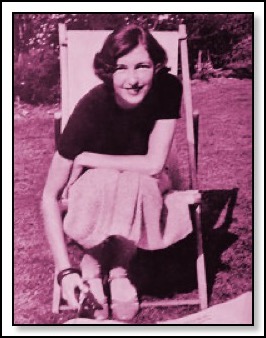
Christine Granville was one of the bravest, toughest and strangest secret agents of World War II. Her feats of derring-do included acting as a courier in Nazi-occupied Europe, parachuting into France in support of the Allied invasion and rescuing three of her comrades from certain execution. She was said to be Winston Churchill’s favorite spy — a considerable accolade given how much Britain’s wartime prime minister liked spies. She may have been the model for Vesper Lynd, the female agent in Ian Fleming’s first James Bond novel, “Casino Royale.” She won medals for bravery from both Britain and France. Men found her irresistible, and she did very little to resist them. (from the NYTBR by Ben Macintyre)
Christine Glanville

Soviet Holocaust Cinema
23/06/13 16:06 Filed in: History
Records, photos, and especially film has been found in the old Soviet archives of how the Soviet Union depicted the Shoah or Holocaust from their vantage point. In the late 1930s, before Germany invaded the Soviet Union, there were films being made that depicted Jews being taken away by Nazis. Many of these films were hidden away once the Molotov-Ribbentrop pact was signed. An interesting story is found here with many interesting photos and film noted.
Hitler's Bunker
30/04/13 16:46 Filed in: History
Today is the anniversary of the death of Hitler and the final death knell of the German phase of World War II. Hitler and Eva Braun, his mistress, committed suicide in his underground bunker in Berlin. When I was in East Berlin in 1969 at the age of 17, they drove us past where they said the bunker had been. There are a number of articles about Hitler’s last days, his death, and where he is buried found here, here, and here.
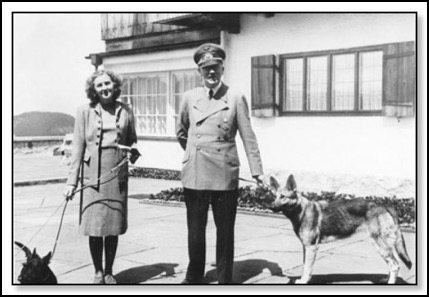

More Katyn Forest
26/04/13 13:52 Filed in: History
- Here is further detail of what happened at Katyn Forest from the Central Intelligence Agency’s website. The full article is here.
Katyn Forest
24/04/13 09:59 Filed in: History
- Looking back in history, one of the biggest mysteries that has been solved yet not made widely known is what happened to the Polish Officers
- who were killed in the Katyn Forest during World War II. For a long period, the Soviet Union had implied the Germans had killed these men. After
- the fall of the Soviet Union, research found that Stalin and the Soviet Union was responsible for this atrocity. A discussion of the coverup is
- covered here.
As the evidence assembled by the Swiss Red Cross showed that this horrible deed was the work of Stalin and his henchmen, the Soviet government dismissed it as a piece of Nazi propaganda . . . . The American press, following the lead of the Office of War Information, played down the story or treated it as another Nazi atrocity.
Hook reported that at the time, Oscar Lange, a pro-Soviet Polish emigre who "tried to pin the responsibility for the massacre on the Germans," challenged his view of the crime. Hook felt strongly enough about the issue to agree to participate in a public debate with Lange, to be held at Columbia University. Unfortunately, the debate did not come off and Lange returned to Poland to work for the Communist regime that Stalin was installing there. Needless to say, to the great disappointment of Hook and others, there was no slowing of the American rush to beneficent judgment of Stalin's regime.
Audie Murphy
17/04/13 21:19 Filed in: History
Three days ago, on Sunday, DISH network had the movie, To Hell and Back. The movie is named after Audie Murphy’s autobiographical account of his feats of bravery fighting against the Germans in the Italian Front in World War II. Audie Murphy is one of the most decorated soldiers in American history and went on to be a well-known actor too. His story is one for the legends, especially since he was in his late teens when he demonstrated such bravery. It is so impressive that he is the only modern day warrior listed in this article on the top 10 warriors in history.
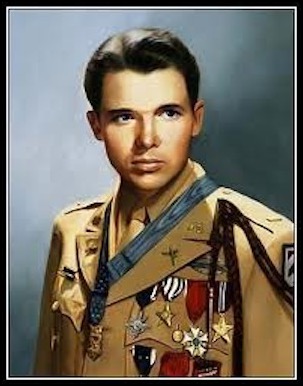

20 Photos
14/04/13 16:19 Filed in: History
On the recent Holocaust Memorial Day. there are links to a site that displayed 20 photos that change the Holocaust narrative. In the midst of the horror and loss of too many lives, people still could smile and have some small bursts of normal life. The people still go on and try for surviving along with their fellow people. They feel the photos show they were survivors, not just victims.
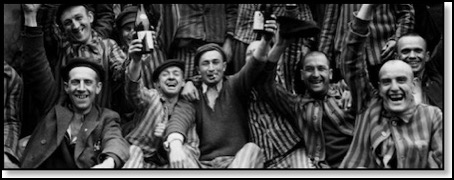

Warsaw Ghetto Uprising
06/04/13 09:00 Filed in: History
Israel holds its Holocaust Remembrance Day tomorrow and it is in conjunction with the Warsaw Ghetto Uprising during World War II. A recent article describes the remembrances of a young girl, now a woman of 84 years of age, whose friends stayed to fight in the uprising while she was sent out of the Ghetto. She and part of her family ended up in Bergen-Belsen and to finally survive the war. She will speak at the remembrance held tomorrow in Israel. One can read about her story here.
Two days before her comrades embarked on an uprising that came to symbolize Jewish resistance against the Nazis in World War II, 14-year-old Aliza Mendel got her orders: Escape from the Warsaw Ghetto.
The end was near. Nazi troops had encircled the ghetto, and the remaining Jewish rebels inside were prepared to die fighting. They had few weapons, and they felt there was no point in giving one of them to a teenage girl whose main task to that point had been distributing leaflets.
"They told me I was too young to fight," said the survivor, now 84, who uses her married name, Aliza Vitis-Shomron. "They said, `You have to leave and tell the world how we died fighting the Nazis. That is your job now.'"
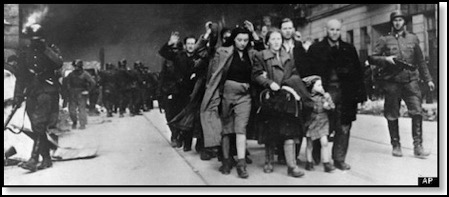
Two days before her comrades embarked on an uprising that came to symbolize Jewish resistance against the Nazis in World War II, 14-year-old Aliza Mendel got her orders: Escape from the Warsaw Ghetto.
The end was near. Nazi troops had encircled the ghetto, and the remaining Jewish rebels inside were prepared to die fighting. They had few weapons, and they felt there was no point in giving one of them to a teenage girl whose main task to that point had been distributing leaflets.
"They told me I was too young to fight," said the survivor, now 84, who uses her married name, Aliza Vitis-Shomron. "They said, `You have to leave and tell the world how we died fighting the Nazis. That is your job now.'"

Hitler and Stalin
05/03/13 15:18 Filed in: History
An author who knows this historical period and its significance has written a piece in the New York Times comparing the quantity versus quality of deaths under Hitler versus Stalin. Who was worse? It would be no lesser of two evils if faced with either.What a truly terrible time in our history and to occur in a civilized 20th Century. Timothy Snyder is the author and I have his one book, Bloodlands. To understand the time, the article in the Times is found here.
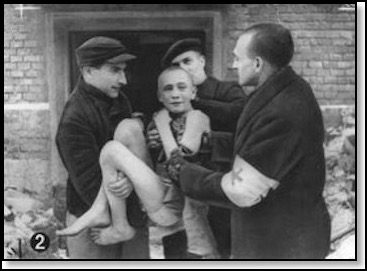

The Great Escape
04/03/13 20:31 Filed in: History
Steve McQueen was a movie star playing in The Great Escape. He could go home to a more glamorous lifestyle. Unfortunately, the story was based on a real life escape from a Stalag in Poland not far from the Baltic. Many escaped and were recaptured. 50 of those were killed in retaliation to the escape on Hitler’s orders. The men who carried out the executions were found by great detective work and put on trial. An interesting story about what is a horrible episode from World War II.
Holocaust News
03/03/13 20:28 Filed in: History
Researchers have found that the number of concentration camps and ghettos used by the Nazis was higher than originally thought. The work indicates there were close to 42,500 of such named places during the war. More details can be found here in this article.
World War II Bunkers
24/02/13 20:26 Filed in: Photography
If you want to see what can be made of long abandoned World War II bunkers in France, Holland, and Belgium, check out this article and the photographs taken of the bunkers in different lighting and in the winter. A lot of history and most likely the stories of men’s lives all wrapped up in these concrete “mansions”.
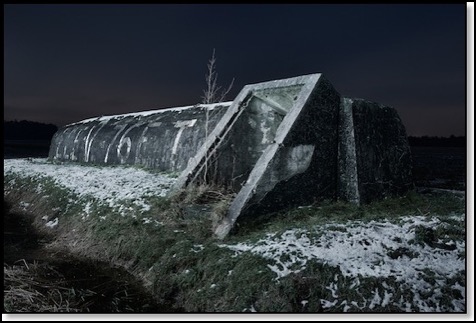

Women of the Gulag
20/02/13 08:22 Filed in: History
One of the saddest and most interesting books I have read in the last few years was Bloodlands by Timothy Snyder. It describes the large area of land in eastern Poland, Ukraine, Belarus, and the Baltics where the Germans and Soviets fought for control before, during, and after World War II. A large portion of the book discussed the Great Famine and Great Terror plus the purge that Stalin wrought on these countries and also the Russian Motherland itself. There will be a new book out called Women of the Gulag. It describes the effects of Stalin’s actions against the men in these women’s’ lives and the spillover to the women. To rise to the top and be brought down by a psychotic megalomaniac afraid of potential rivals. An article describing the book and 5 of the women is found here. A page related to this topic is also here.
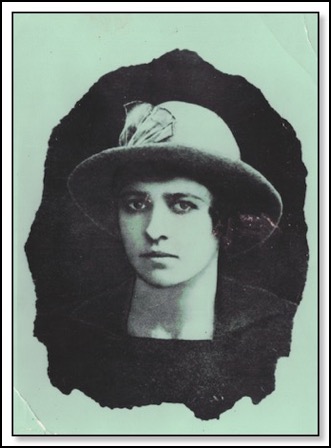

Bomber Jackets
10/12/12 08:59 Filed in: Interests
What we collect or what interests us, defines us. One type of collectible that has a following is in the paintings found on World War II leather bomber jackets. I came across a fascinating article about this form of collectible. To my amazement, the first picture in the story was of a jacket painted “Winn’s Warriors”. Oh, to have that jacket what with my role in the Winn Feline Foundation. We should all have the motto of Winn’s Warriors as we volunteer for this wonderful Foundation. As the artwork emboldened our air boys, something similar might make us emboldened to work hard for cat health studies to make the lives of cats even better. To read about the bomber jacket art of World War II, go here.


London Blitz
28/10/12 09:54 Filed in: Interests
Here is an interesting video noted on a webpage that gives a different look to how the people of London dealt with the blitzkrieg unleashed by Germany in World War II. I am now reading a book called Savage Continent about life in Europe from 1944 to 1949. The start of the book mentions how many homes and structures were destroyed during this phase of the war. 202,000 homes were destroyed and 4.5 million were damaged in the London area.
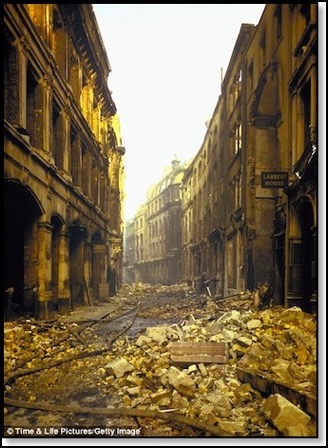

World War II Remembered
21/10/12 08:50 Filed in: Family
There was a recent online article that reminded one of the action in World War II. The authors had photos where soldiers photo images were superimposed over locations past and present of action during the War in the European theatre. The superimposition gives the impression in a way of ghost soldiers, much like the sensation as you walk the Korean War Memorial in Washington DC.
My father joined the Army before the war started and was stationed in Central America on Trinidad Island and Panama. Dad was in Panama from what I understand when the war started. He spent the War stationed at the Pentagon where he claimed he was a clerk. I like to think he knew secrets that helped win the War for the Allies.
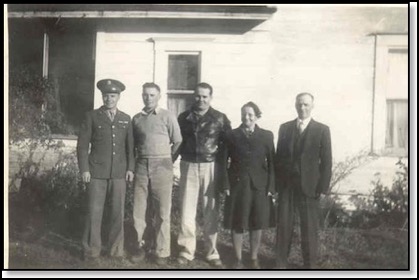
My father joined the Army before the war started and was stationed in Central America on Trinidad Island and Panama. Dad was in Panama from what I understand when the war started. He spent the War stationed at the Pentagon where he claimed he was a clerk. I like to think he knew secrets that helped win the War for the Allies.


